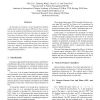115
Voted
ICIP
2009
IEEE
16 years 1 months ago
2009
IEEE
In this paper, we present a novel method for 3D face recognition using adaboosted geodesic distance features. Firstly, a generic model is finely conformed to each face model conta...
110
Voted
ICPR
2002
IEEE
16 years 1 months ago
2002
IEEE
One of the major difficulties in face recognition systems is the in-depth pose variation problem. Most face recognition approaches assume that the pose of the face is known. In th...
91
Voted
ICPR
2004
IEEE
16 years 1 months ago
2004
IEEE
In this paper, we propose a novel classification method, called nearest intra-class space (NICS), for face recognition. In our method, the distribution of face patterns of each pe...
81
Voted
ICPR
2006
IEEE
16 years 1 months ago
2006
IEEE
One possible solution for pose- and illuminationinvariant face recognition is to employ appearancebased approaches, which rely greatly on correct facial textures. However, existin...
ICPR
2006
IEEE
16 years 1 months ago
2006
IEEE
In this paper we consider face recognition from sets of face images and, in particular, recognition invariance to illumination. The main contribution is an algorithm based on the ...
97
Voted
ICPR
2008
IEEE
16 years 1 months ago
2008
IEEE
Recently, psychological studies showed that averaging human face images greatly improves the performance of face recognition under various pose, illumination, expression, and/or a...
103
Voted
ICIP
1999
IEEE
16 years 2 months ago
1999
IEEE
A common feature found in practically all technical approaches proposed for face recognition is the use of only the luminance information associated to the face image. One may won...
94
Voted
ICIP
1999
IEEE
16 years 2 months ago
1999
IEEE
An integral scheme that provides a global eigen approach to the problem of face recognition of still images has been presented in [1]. The scheme is based on the representation of...
99
Voted
ICIP
2004
IEEE
16 years 2 months ago
2004
IEEE
There is a rapidly growing demand for using smart cameras for various biometric applications in surveillance. Although having a small form-factor, most of these applications deman...
85
Voted
ICIP
2005
IEEE
16 years 2 months ago
2005
IEEE
Recently many Automatic Face Recognition (AFR) systems were developed for applications with unspecific persons, which is different from conventional pattern recognition problems wh...



